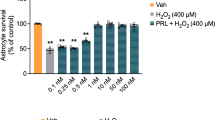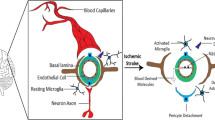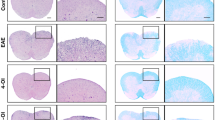Abstract
Neuroinflammation plays a key role in the pathogenesis of neurodegenerative diseases. Microglial cells are the main immune cells of the central nervous system. On exposure to lipopolysaccharides (LPS, components of the cell wall of Gram-negative enterobacteria), microglia is activated to produce reactive oxygen species (ROS), cytokines, and inflammatory mediators, which may cause neuron death. Exogenous recombinant human heat shock protein 70 (HSP70) was tested for effect on the activation of human microglial and neuroblastoma cells in response to LPS from Escherichia coli. Experiments included cell cultivation separately and transferring the conditioned medium from A-172 microglial cells to SK-N-SH neuroblastoma cells to simulate the effect of microglia treated with LPS and/or HSP70. The levels of ROS, TNFα, and apoptosis in LPS-treated cells were estimated in the presence or absence of HSP70. HSP70 was found to reduce the LPS-induced ROS generation, TNFα production, apoptosis, and necrosis, in both separate cell cultures and neuroblastoma cells grown in the conditioned medium from microglial cells. Signaling pathways involving protein kinases p38MAPK, JNK, and PI3K were demonstrated to play an important role in HSP70-mediated protection of microglial and neuroblastoma cells from LPS-induced apoptosis and ROS production.






Similar content being viewed by others
REFERENCES
Catorce M.N., Gevorkian G. 2016. LPS-induced murine neuroinflammation model: Main features and suitability for pre-clinical assessment of nutraceuticals. Curr. Neuropharmacol. 14, 155–164.
Muhammad T., Ali T., Ikram M., Khan A., Alam S.I., Kim M. 2018. Melatonin rescue oxidative stress-mediated neuroinflammation/neurodegeneration and memory impairment in scopolamine-induced amnesia mice model. J. Neuroimmun. Pharmacol. 14 (2), 278–294. https://doi.org/10.1007/s11481-018-9824-3
DeFrancesco-Lisowitz A., Lindborg J., Niemi J., Zigmond R. 2015. The neuroimmunology of degeneration and regeneration in the peripheral nervous system. Neuroscience.302, 174–203.
Pintado C., Gavilán M.P., Gavilán E., García-Cuervo L., Gutiérrez A., Vitorica J., Castaño A., Ríos R.M., Ruano D. 2012. Lipopolysaccharide-induced neuroinflammation leads to the accumulation of ubiquitinated proteins and increases susceptibility to neurodegeneration induced by proteasome inhibition in rat hippocampus. J. Neuroinflamm. 9, 87.
Barron H., Hafizi S., Andreazza A.C., Mizrahi R. 2017. Neuroinflammation and oxidative stress in psychosis and psychosis risk. Int. J. Mol. Sci. 18 (3), 651.
Pretorius E., Bester J., Page M., Kell D. 2018. The potential of LPS-binding protein to reverse amyloid formation in plasma fibrin of individuals with Alzheimer-type dementia. Front. Aging Neurosci. 10, 257.
Prinz M., Priller J. 2014. Microglia and brain macrophages in the molecular age: Origin to neuropsychiatric disease. Nat. Rev. Neurosci. 15, 300–312.
Lannes N., Eppler E., Etemad S., Yotovski P., Filgueira L. 2017. Microglia at center stage: A comprehensive review about the versatile and unique residential macrophages of the central nervous system. Oncotarget. 8 (69), 114393–114413.
Graeber M., Streit W. 2010. Microglia: Biology and pathology. Acta Neuropathol. 119, 89–105.
More S., Kumar H., Kim I., Koppulla S., Kim B., Choi D. 2013. Strategic selection of neuroinflammatory models in Parkinson’s disease: Evidence from experimental studies. CNS Neurol. Disord. Drug Targets. 12, 680–697.
Qin L., Liu Y., Hong J., Crews F. 2013. NADPH oxidase and aging drive microglial activation, oxidative stress and dopaminergic neurodegeneration following systemic LPS administration. Glia.61, 855–868.
Wang G., Zhang J., Hu X., Zhang L., Mao L., Jiang X., Liou A.K., Leak R.K., Gao Y., Chen J. 2013. Microglia/macrophage polarization dynamics in white matter after traumatic brain injury. J. Cereb. Blood Flow Metab. 33, 1864–1874.
Loane D., Kumar A., Stoica B., Cabatbat R., Faden A. 2014. Progressive neurodegeneration after experimental brain trauma: Association with chronic microglial activation. J. Neuropathol. Exp. Neurol. 73, 14–29.
Kim S., Kim H. 2017. Dynamic lipopolysaccharide transfer cascade to TLR4/MD2 complex via LBP and CD14. BMB Rep. 50 (2), 55–57.
Kuzmich N., Sivak K., Chubarev V., Porozov Y., Savateeva-Lyubimova T., Peri F. 2017. TLR4 signaling pathway modulators as potential therapeutics in inflammation and sepsis. Vaccines (Basel). 5 (4), pii: E34.
Muhammad T., Ikram M., Ullah R., Rehman S., Kim M. 2019. Hesperetin, a citrus flavonoid, attenuates lps-induced neuroinflammation, apoptosisand memory impairments by modulating TLR4/NF-κB signaling. Nutrients. 11 (3), pii: E648.
Qu B., Jia Y., Liu Y, Wang H., Ren G., Wang H. 2015. The detection and role of heat shock protein 70 in various nondisease conditions and disease conditions: A literature review. Cell Stress Chaperones. 20 (6), 885–892.
Radons J. 2016. The human HSP70 family of chaperones: Where do we stand? Cell Stress Chaperones. 21 (3), 379–404.
Dahiya V., Buchner J. 2019. Functional principles and regulation of molecular chaperones. Adv. Protein Chem. Struct. Biol. 114, 1–60.
Yu W., Cao S., Zang C., Wang L., Yang H., Bao X., Zhang D. 2018. Heat shock protein 70 suppresses neuroinflammation induced by α-synuclein in astrocytes. Mol. Cell Neurosci. 86, 58–64.
Streicher J. 2019. The role of heat shock proteins in regulating receptor signal transduction. Mol. Pharmacol.95 (5), 468–474.
Pockley A., Henderson B. 2018. Extracellular cell stress (heat shock) proteins-immune responses and disease: An overview. Philos. Trans. R. Soc. Lond. B. Biol. Sci.373 (1738). pii: 20160522.
Rozhkova E., Yurinskaya M., Zatsepina O., Garbuz D., Surkov S., Murashev A., Ostrov V., Margulis B., Evgen’ev M., Vinokurov M. 2010. Exogenous mammalian extracellular HSP70 reduces endotoxin manifestations at the cellular and organism levels. Ann. N. Y. Acad. Sci. 1197, 94–107.
Yurinskaya M., Kochetkova O., Shabarchina L., Antonova O., Suslikov A., Evgen’ev M., Vinokurov M. 2017. Encapsulated Hsp70 decreases endotoxin-induced production of ROS and TNFα in human phagocytes. Cell Stress Chaperones. 22 (1), 163–171.
Yurinskaya M., Mitkevich V., Kozin S., Evgen’ev M., Makarov A., Vinokurov M. 2015. HSP70 protects human neuroblastoma cells from apoptosis and oxidative stress induced by amyloid peptide isoAsp7-Aβ(1-42). Cell. Death Dis. 19 (6), e1977.
Evgen'ev M., Krasnov G., Nesterova I., Garbuz D., Karpov V., Morozov A., Snezhkina A., Samokhin A., Sergeev A., Kulikov A., Bobkova N. 2017. Molecular mechanisms underlying neuroprotective effect of intranasal administration of human Hsp70 in mouse model of Alzheimer’s disease. J. Alzheimers Dis. 59 (4), 1415–1426.
Pfister H., Hennet T., Jungi T. 1992. Lipopolysaccharide synergizes with tumour necrosis factor-alpha in cytotoxicity assays. Immunology. 77 (3), 473–476.
Wang X., Hu D., Zhang L., Lian G., Zhao S., Wang C., Yin J., Wu C., Yang J. 2014. Gomisin A inhibits lipopolysaccharide-induced inflammatory responses in N9 microglia via blocking the NF-κB/MAPKs pathway. Food Chem. Toxicol.63, 119–127.
Yin L., Li W., Chu Y., Li L. 2011. ERK pathway activation is required for amyloid-β(1-40)(-)induced neurotoxicity of THP-1 human monocytes towards SK-N-SH neuroblastoma. Brain Res. 1378, 9–17.
Yao L., Ye Y., Mao H., Lu F., He X., Lu G., Zhang S. 2018. MicroRNA-124 regulates the expression of MEKK3 in the inflammatory pathogenesis of Parkinson’s disease. J. Neuroinflammation. 15 (1), 13.
Giraldo E., Martin-Cordero L., Garcia J., Gerhmann M., Multhoff G., Ortega E. 2010. Exercise-induced extracellular 72 kDa heat shock protein (Hsp72) stimulates neutrophil phagocytic and fungicidal capacities via TLR-2. Eur. J. Appl. Physiol. 108 (2), 217–225.
Xie Z., Smith C., Van Eldik L. 2004. Activated glia induces neuron death via MAP kinase signaling pathways involving JNK and p38. Glia.45 (2), 170–179.
Xiang W., Chao Z., Feng D. 2015. Role of Toll-like receptor/myd88 signaling in neurodegenerative diseases. Rev. Neurosci. 26 (4), 407–414
Hassan F., Islam S., Tumurkhuu G., Naiki Y., Koide N., Mori I., Yoshida T., Yokochi T. 2006. Intracellular expression of toll-like receptor 4 in neuroblastoma cells and their unresponsiveness to lipopolysaccharide. BMC Cancer. 6, 281.
Trotta T., Porro C., Calvello R., Panaro M. 2014. Biological role of toll-like receptor-4 in the brain. J. Neuroimmunol. 268 (1–2), 1–12.
Cui Y., Wang Y., Zhao D., Feng X., Zhang L., Liu C. 2018. Loganin prevents BV-2 microglia cells from Aβ1-42-induced inflammation via regulating TLR4/ TRAF6/NF-κB axis. Cell. Biol. Int.42 (12), 1632–1642.
Calvo-Rodríguez M., de la Fuente C., García-Durillo M., García-Rodríguez C., Villalobos C., Núñez L. 2017. Aging and amyloid β oligomers enhance TLR4 expression, LPS-induced Ca2+responses, and neuron cell death in cultured rat hippocampal neurons. J. Neuroinflamm.14 (1), 24.
Gibbons H., Dragunow M. 2006. Microglia induce neural cell death via a proximity-dependent mechanism involving nitric oxide. Brain Res. 1084 (1), 1–15.
Asehnoune K., Strassheim D., Mitra S., Kim J., Abraham E. 2004. Involvement of reactive oxygen species in Toll-like receptor 4-dependent activation of NF-kappa B. J. Immunol. 172 (4), 2522–2529.
Park H., Jung H., Park E., Kim J., Lee W., Bae Y. 2004. Direct interaction of TLR4 with NAD(P)H oxidase 4 isozyme is essential for lipopolysaccharide-induced production of reactive oxygen species and activation of NF-kappa B. J. Immunol.173 (6), 3589–3593.
Nadeau S., Rivest S. 2000. Role of microglial-derived tumor necrosis factor in mediating CD14 transcription and nuclear factor kappa B activity in the brain during endotoxemia. J. Neurosci. 20, 3456–3468.
Yurinskaya M.M., Mit’kevich V.A., Barykin E.P., Garbuz D.G., Evgen’ev M.B., Makarov A.A., Vinokurov M.G. 2015. Heat-shock protein HSP70 protects neuroblastoma cells SK-N-SH from the neurotoxic effects of hydrogen peroxide and the β-amyloid peptide. Mol. Biol. (Moscow). 49 (6), 924–927.
Asea A., Rehli M., Kabingu E., Boch J., Bare O., Auron P., Stevenson M., Calderwood S. 2002. Novel signal transduction pathway utilized by extracellular HSP70: Role of toll-like receptor (TLR) 2 and TLR4. J. Biol. Chem. 277, 15028–15034.
Yurinskaya M., Zatsepina O., Vinokurov M., Bobkova N., Garbuz D., Morozov A., Kulikova D., Mitkevich V., Makarov A., Funikov S., Evgen’ev M.. 2015. The fate of exogenous human HSP70 introduced into animal cells by different means. Curr. Drug Deliv.12 (5), 524–532.
Kacimi R., Yenari M. 2015. Pharmacologic heat shock protein 70 induction confers cytoprotection against inflammation in gliovascular cells. Glia.63 (7), 1200–1212.
Subedi L., Ji E., Shin D., Jin J., Yeo J., Kim S. 2017. Equol, a dietary daidzein gut metabolite attenuates microglial activation and potentiates neuroprotection in vitro.Nutrients. 9 (3), 207.
Rahimifard M., Maqbool F., Moeini-Nodeh S., Niaz K., Abdollahi M., Braidy N., Nabavi S., Nabavi S. 2017. Targeting the TLR4 signaling pathway by polyphenols: A novel therapeutic strategy for neuroinflammation. Ageing Res. Rev. 36, 11–19.
Hao Y., Feng Y., Li J., Gu X. 2018. Role of MAPKs in Hsp70’s protection against heat stress-induced injury in rat small intestine. Biomed. Res. Int.12, 1571406.
Gourgou E., Aggeli I., Beis I., Gaitanaki C. 2010. Hyperthermia-induced Hsp70 and MT20 transcriptional upregulation are mediated by p38-MAPK and JNKs in Mytilus galloprovincialis (Lamarck): A pro-survival response. J. Exp. Biol. 213 (2), 347–357.
Funding
This work was supported by the Russian Foundation for Basic Research (project no. 19-04-00109). Isolation and purification of recombinant human HSP70 were supported by the Russian Science Foundation (project no. 19-14-00167) (D.G.).
Author information
Authors and Affiliations
Corresponding author
Ethics declarations
This article does not contain any studies involving animals or human subjects performed by any of the authors.
Conflict of interests. The authors declare that they have no conflict of interest.
Additional information
Translated by T. Tkacheva
Abbreviations: HSP70, heat shock protein, 70 kDa; LPS, lipopolysaccharide; ROS, reactive oxygen species.
Rights and permissions
About this article
Cite this article
Yurinskaya, M.M., Garbuz, D.G., Evgen’ev, M.B. et al. Exogenous HSP70 and Signaling Pathways Involved in the Inhibition of LPS-Induced Neurotoxicity of Neuroblastoma Cells. Mol Biol 54, 111–118 (2020). https://doi.org/10.1134/S0026893320010161
Received:
Revised:
Accepted:
Published:
Issue Date:
DOI: https://doi.org/10.1134/S0026893320010161




